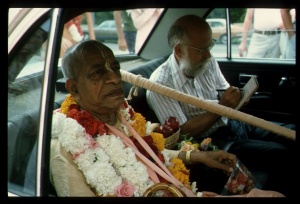SB 10.2.13: Difference between revisions
m (1 revision(s)) |
No edit summary |
||
| Line 1: | Line 1: | ||
{{info | {{info | ||
|speaker=Lord | |speaker=Lord Kṛṣṇa the Supreme Personality of Godhead | ||
|listener= | |listener=Yogamāyā | ||
}} | }} | ||
[[Category:Srimad-Bhagavatam - Canto 10 Chapter 02]] | |||
[[Category:Bhagavatam Verses Spoken by Lord Krsna - Vanisource|100213]] | |||
<div style="float:left">'''[[Srimad-Bhagavatam]] - [[SB 10|Tenth Canto]] - [[SB 10.2: Prayers by the Demigods for Lord Krsna in the Womb|Chapter 2: Prayers by the Demigods for Lord Kṛṣṇa in the Womb]]'''</div> | |||
<div style="float:right">[[File:Go-previous.png|link=SB 10.2.11-12]] '''[[SB 10.2.11-12]] - [[SB 10.2.14]]''' [[File:Go-next.png|link=SB 10.2.14]]</div> | |||
{{RandomImage}} | |||
==== TEXT 13 ==== | ==== TEXT 13 ==== | ||
<div | <div class="verse"> | ||
garbha-saṅkarṣaṇāt taṁ vai | :garbha-saṅkarṣaṇāt taṁ vai | ||
prāhuḥ saṅkarṣaṇaṁ bhuvi | :prāhuḥ saṅkarṣaṇaṁ bhuvi | ||
rāmeti loka-ramaṇād | :rāmeti loka-ramaṇād | ||
balabhadraṁ balocchrayāt | :balabhadraṁ balocchrayāt | ||
</div> | </div> | ||
| Line 17: | Line 22: | ||
==== SYNONYMS ==== | ==== SYNONYMS ==== | ||
<div | <div class="synonyms"> | ||
garbha- | ''garbha-saṅkarṣaṇāt''—because He will be taken from the womb of Devakī to that of Rohiṇī; ''tam''—Him (Rohiṇī-nandana, the son of Rohiṇī); ''vai''—indeed; ''prāhuḥ''—people will call; ''saṅkarṣaṇam''—by the name Saṅkarṣaṇa; ''bhuvi''—in the world; ''rāma iti''—He will also be called Rāma; ''loka-ramaṇāt''—because of His special mercy in enabling people in general to become devotees; ''balabhadram''—He will also be called Balabhadra; ''bala-ucchrayāt''—because of extensive bodily strength. | ||
</div> | </div> | ||
| Line 24: | Line 29: | ||
==== TRANSLATION ==== | ==== TRANSLATION ==== | ||
<div | <div class="translation"> | ||
The son of Rohiṇī will also be celebrated as Saṅkarṣaṇa because of being sent from the womb of Devakī to the womb of Rohiṇī. He will be called Rāma because of His ability to please all the inhabitants of Gokula, and He will be known as Balabhadra because of His extensive physical strength. | The son of Rohiṇī will also be celebrated as Saṅkarṣaṇa because of being sent from the womb of Devakī to the womb of Rohiṇī. He will be called Rāma because of His ability to please all the inhabitants of Gokula, and He will be known as Balabhadra because of His extensive physical strength. | ||
</div> | </div> | ||
| Line 31: | Line 36: | ||
==== PURPORT ==== | ==== PURPORT ==== | ||
<div | <div class="purport"> | ||
These are some of the reasons why Balarāma is known as Saṅkarṣaṇa, Balarāma or sometimes Rāma. In the mahā- | These are some of the reasons why Balarāma is known as Saṅkarṣaṇa, Balarāma or sometimes Rāma. In the ''mahā-mantra''—Hare Kṛṣṇa, Hare Kṛṣṇa, Kṛṣṇa Kṛṣṇa, Hare Hare/ Hare Rāma, Hare Rāma, Rāma Rāma, Hare Hare—people sometimes object when Rāma is accepted as Balarāma. But although devotees of Lord Rāma may object, they should know that there is no difference between Balarāma and Lord Rāma. Here [[Srimad-Bhagavatam|''Śrīmad-Bhāgavatam'']] clearly states that Balarāma is also known as Rāma (''rāmeti''). Therefore, it is not artificial for us to speak of Lord Balarāma as Lord Rāma. Jayadeva Gosvāmī also speaks of three Rāmas: Paraśurāma, Raghupati Rāma and Balarāma. All of them are Rāmas. | ||
</div> | </div> | ||
__NOTOC__ | |||
<div style="float:right; clear:both;">[[File:Go-previous.png|link=SB 10.2.11-12]] '''[[SB 10.2.11-12]] - [[SB 10.2.14]]''' [[File:Go-next.png|link=SB 10.2.14]]</div> | |||
__NOTOC__ | |||
__NOEDITSECTION__ | |||
Revision as of 08:43, 18 May 2021

A.C. Bhaktivedanta Swami Prabhupada
TEXT 13
- garbha-saṅkarṣaṇāt taṁ vai
- prāhuḥ saṅkarṣaṇaṁ bhuvi
- rāmeti loka-ramaṇād
- balabhadraṁ balocchrayāt
SYNONYMS
garbha-saṅkarṣaṇāt—because He will be taken from the womb of Devakī to that of Rohiṇī; tam—Him (Rohiṇī-nandana, the son of Rohiṇī); vai—indeed; prāhuḥ—people will call; saṅkarṣaṇam—by the name Saṅkarṣaṇa; bhuvi—in the world; rāma iti—He will also be called Rāma; loka-ramaṇāt—because of His special mercy in enabling people in general to become devotees; balabhadram—He will also be called Balabhadra; bala-ucchrayāt—because of extensive bodily strength.
TRANSLATION
The son of Rohiṇī will also be celebrated as Saṅkarṣaṇa because of being sent from the womb of Devakī to the womb of Rohiṇī. He will be called Rāma because of His ability to please all the inhabitants of Gokula, and He will be known as Balabhadra because of His extensive physical strength.
PURPORT
These are some of the reasons why Balarāma is known as Saṅkarṣaṇa, Balarāma or sometimes Rāma. In the mahā-mantra—Hare Kṛṣṇa, Hare Kṛṣṇa, Kṛṣṇa Kṛṣṇa, Hare Hare/ Hare Rāma, Hare Rāma, Rāma Rāma, Hare Hare—people sometimes object when Rāma is accepted as Balarāma. But although devotees of Lord Rāma may object, they should know that there is no difference between Balarāma and Lord Rāma. Here Śrīmad-Bhāgavatam clearly states that Balarāma is also known as Rāma (rāmeti). Therefore, it is not artificial for us to speak of Lord Balarāma as Lord Rāma. Jayadeva Gosvāmī also speaks of three Rāmas: Paraśurāma, Raghupati Rāma and Balarāma. All of them are Rāmas.